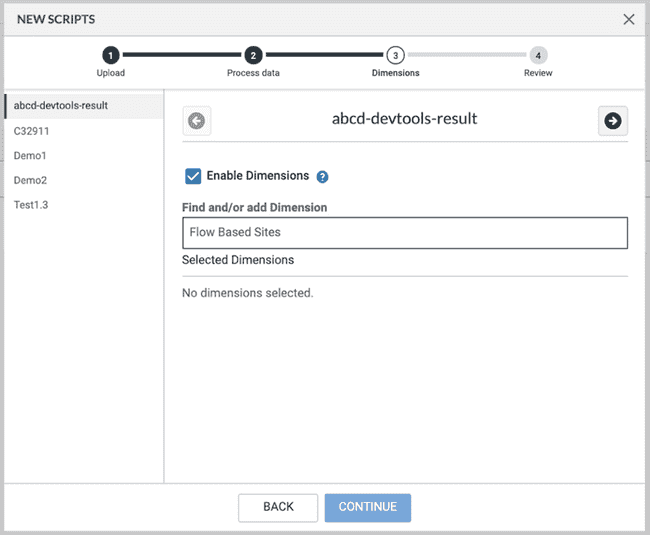Configuring Scripts
Axe Reports supports importing accessibility issues data generated using axe DevTools® for Web APIs/CLI. The data is grouped by individual ‘Script’. A script can be thought of as a group of related pages that are scanned using one or more spec files (for axe DevTools® for Web CLI), or using automated tests (for axe DevTools® for Web API). These are specific configurations that need to be made in the code so that the output JSON files are generated with appropriate keys embedded that are utilized by axe® Reports for correct data representation.
Configuration in axe DevTools® for Web CLI
When utilizing spec files to generate output to be imported into axe® Reports, the ‘id’ configured for each project object in the projects array becomes the name of the script. The ‘name’ for each page in the ‘pageList’ array represents each page in that script. In the example below, ‘Homepage’ is a page within the script ‘deque-main’. It also contains another page called ‘AxeDashboard’ (spaces are taken out by axe DevTools® CLI from the output) in a script named ‘deque-axe’.

You can configure dimensions in axe® Reports to align the accessibility data generated by axe DevTools® for Web scripts with your organizational reporting structure. You start from the top of your reporting structure and build your tree down. In building the tree, you are also setting the drill-down structure from your top dimension to your lowest level (script).
Configure Scripts - First time data setup
Axe DevTools for Web data needs to be uploaded into axe® Reports through results file upload. Follow the steps below to configure and upload axe DevTools® data into axe® Reports.
-
Select the Manage Scripts option from under the Configure section on the left hand corner of the screen.
-
Activate ‘Add New Scripts' dialog box using either the Add New Scripts button on the right of the screen, or use the Add a new Script link.
-
Activate ‘Select Files’ on the ‘New Scripts’ modal, and choose the files to be uploaded. You can upload up to 20 files (max 10 MB size each) in a single upload operation. These files also need to be valid DevTools for Web output files.
-
Activate ‘Select Files’ on the ‘New Scripts’ modal, and choose the files to be uploaded. You can upload up to 20 files (max 10 MB size each) in a single upload operation. These files also need to be valid DevTools for Web output files.

-
Axe Reports provides details on the number of issues found on each file with the ability to remove any of the uploaded files. Once you have verified the information, activate ‘Continue’ to move to the next step.
-
Axe Reports validates the data being uploaded against any data already present in the system to check for any duplication. In case of duplicate data, the system provides a warning about the duplicates, and provide an ability to overwrite the existing data. After verifying data, activate the ‘Continue’ button to go to the next step.
In our example, all the data is new, as indicated by the icons next to each page listing. This example also lists out the two scripts that were added - website1, and website2.
-
For any new scripts added, the system prompts for the configuration of Dimensions (Organizational Hierarchy levels) . The scan data for projects associated to the same dimensions are combined into rollup values. To start adding dimensions, enable the checkbox Enable Dimensions.
-
The data needs to be entered in a top-down structure that matches your organization’s reporting hierarchy. The first Dimension to be entered should be the top-most level of reporting, followed by the next lower level. This sequence is followed until the level that the selected script rolls up to is entered. You have the ability to move the added dimensions up or down to meet your reporting needs.
Any existing dimensions in the system are automatically suggested as you type letters matching these dimensions.
Note You can create a maximum of six dimensions per script. The dimension name can only be up to forty characters long.
-
Once you have the correct order of dimensions configured for the selected script, activate the ‘Next Script’ control (shown as item b in the screenshot) to move to the next Script.
-
Repeat the same steps for the remaining Scripts. You can choose to apply the same dimension that you applied to the previous project by activating the control to ‘Use last applied Dimensions’.

Configuration is not complete until you have configured all the selected scripts. If you would like to delay configuration for any of the previously selected scripts, you can navigate back to the previous step and remove the script from your selection.
-
Once you have the correct order of dimensions configured for the selected script, navigate to the next script by activating the script name from the list of projects in the left navigation panel.
-
Activate the Continue button
-
A Review screen appears showing all the configurations you have performed. Activate ‘Finish’ to confirm or ‘Back’ to make changes.
-
A confirmation screen appears with all the Scripts configured shown.
Result: Once the configurations are submitted, data is available in axe® Reports on the Charts view. If new files are uploaded for the same scripts and pages, but new dates, the step to configure dimension is skipped by the script upload utility.







